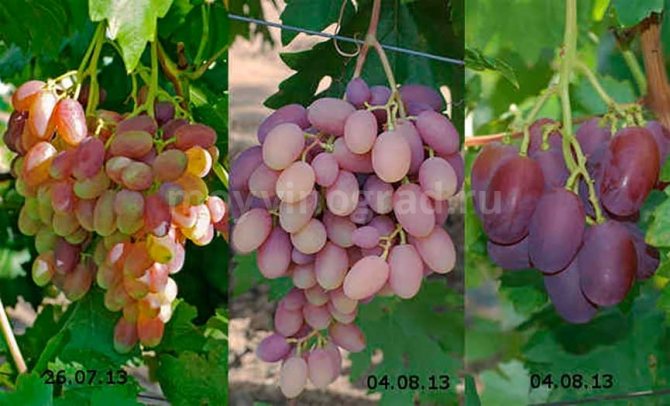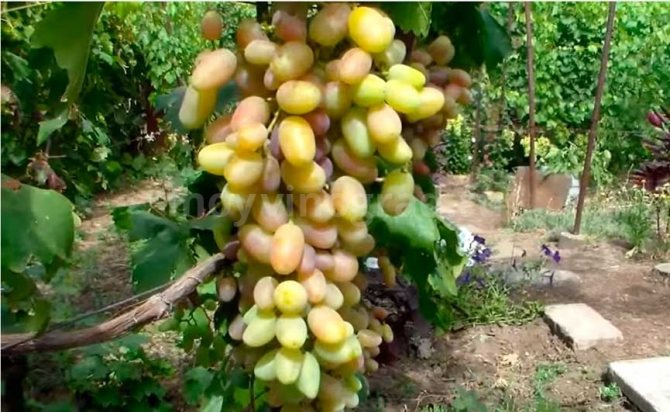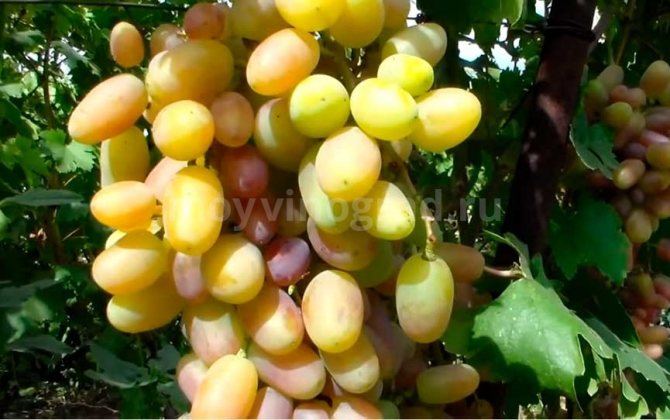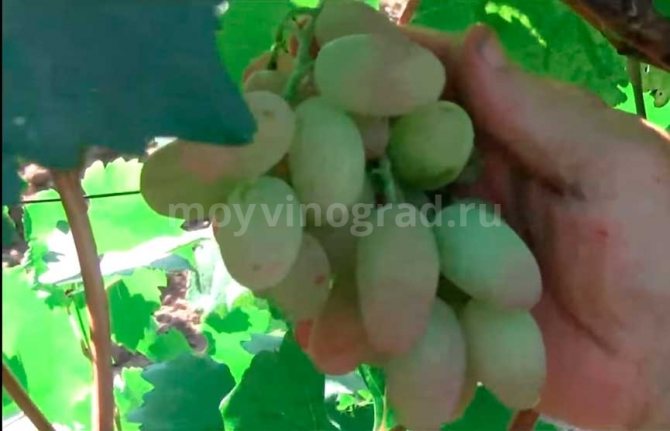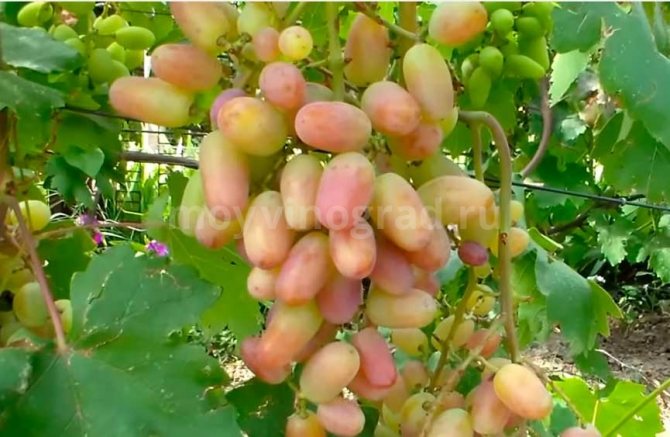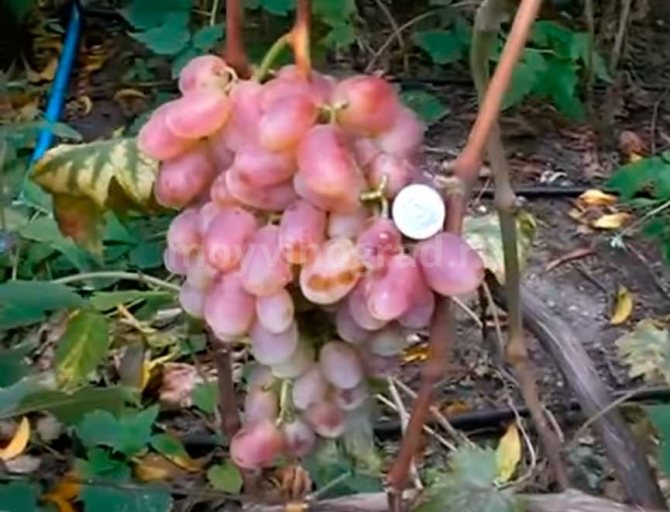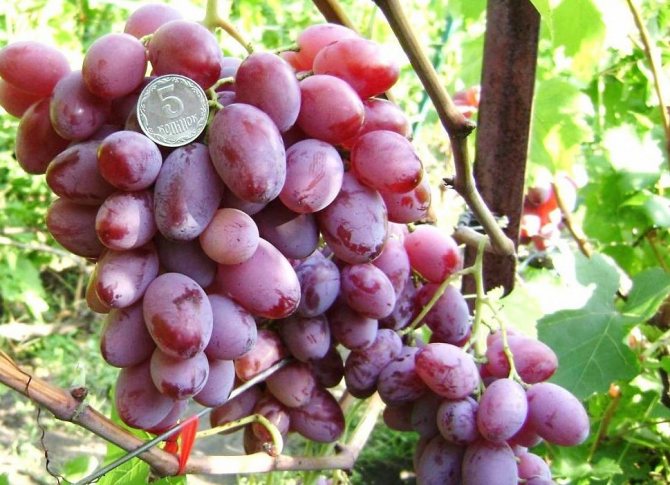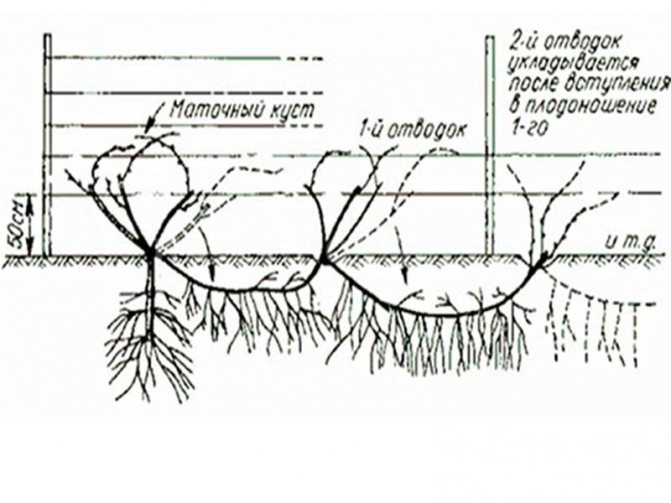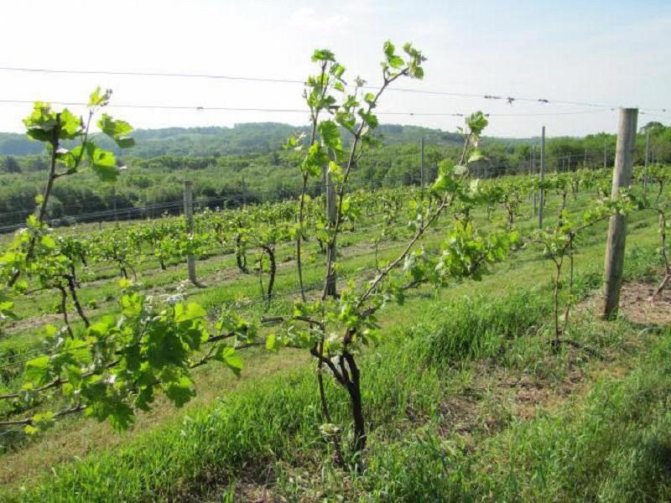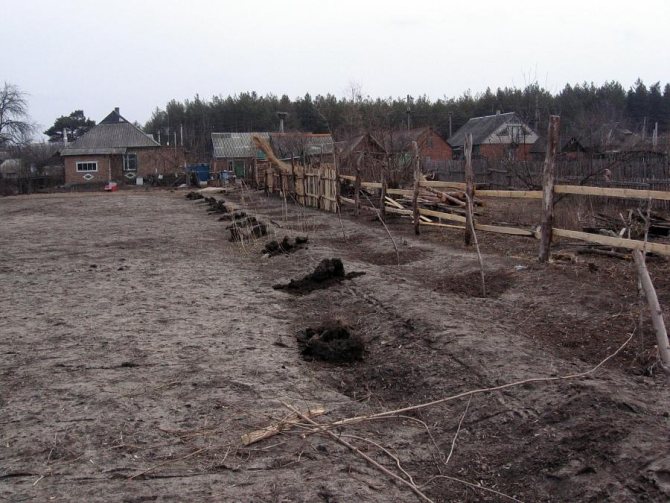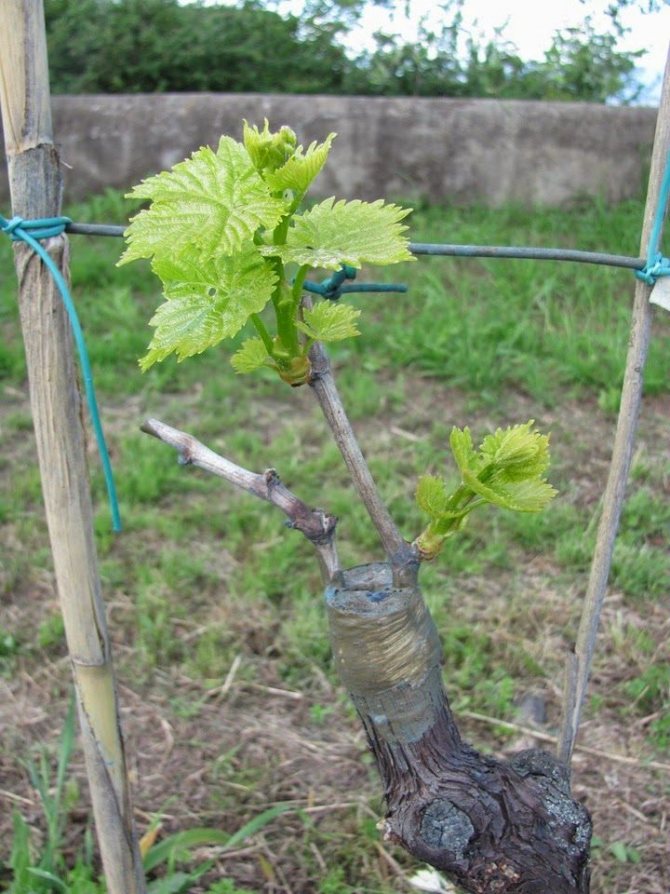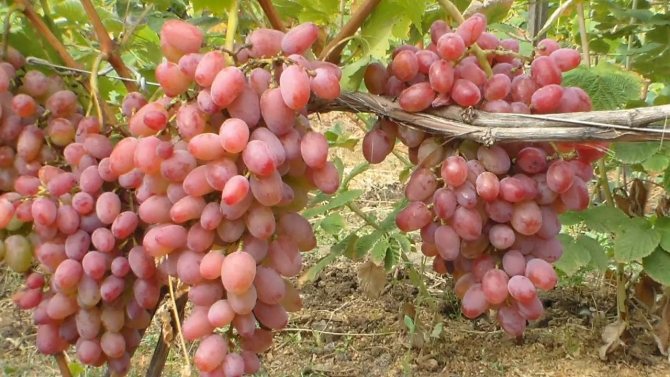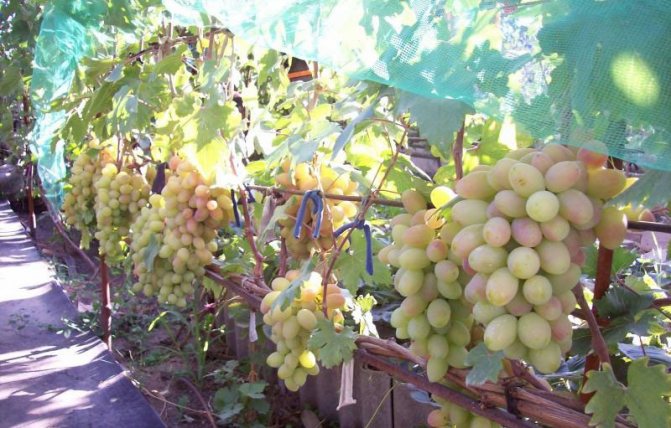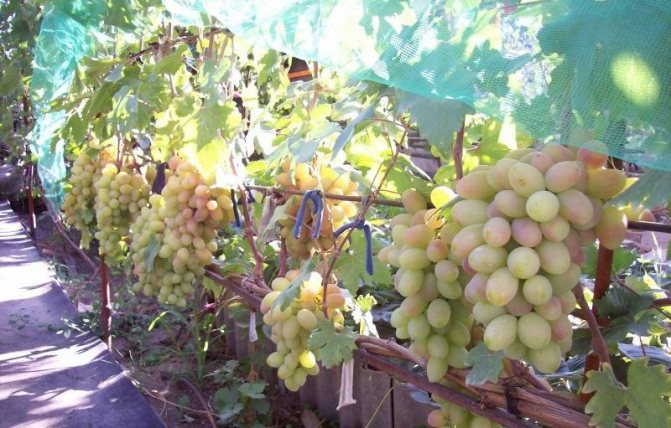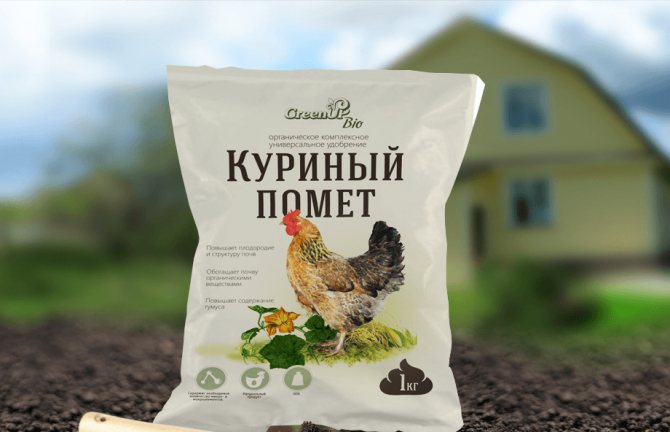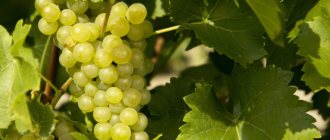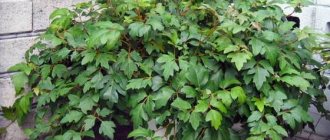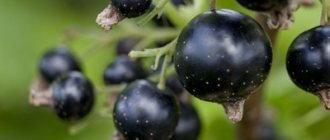Description of the grape variety Victor
The Victor grape belongs to the early varieties. For full maturation, it takes only 100-110 days. The plant is vigorous. The vine looks massive, has an abundance of buds. The flowers are bisexual, begin to open in early June and at the same time quickly pollinate. The bunches grow in the shape of a cone, weighing 500-1000 g on average.
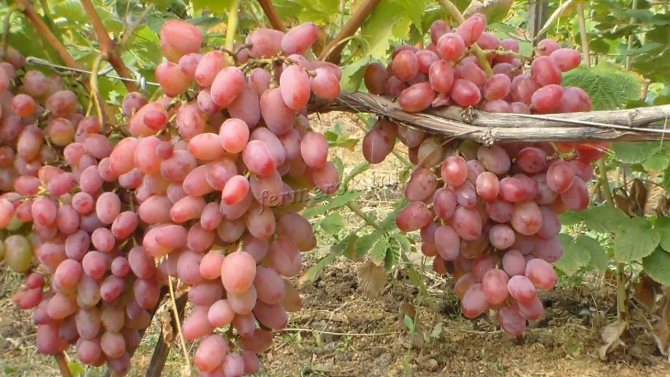
Photo of grape variety Victor
Interesting!
If you cut off excess foliage during the growth of the bunches, the bunches can grow much larger.
The berries grow very large, weighing about 17 grams and measuring 42x26 mm, but there are also champions. The shape of a grape is like an elongated oval with a slightly pointed tip. The peel is dense, but practically not felt during the meal. The color of the peel is from light pink to dark pink - depending on the amount of sunlight and the degree of ripeness. The pulp is fleshy, with a high content of juice. There may be seeds, but there are not many of them, usually a large berry has up to 2 developed seeds. The taste is harmonious and sweet.
Pests
Phyloxera is a small insect, about 1 mm in size, which mainly damages the root system of grapes. It can lead to decay and death of the roots and the death of the bush. There is also a leaf form of the insect, in this case, phylloxera colonies form galls or swellings on the leaf plates of grapes.
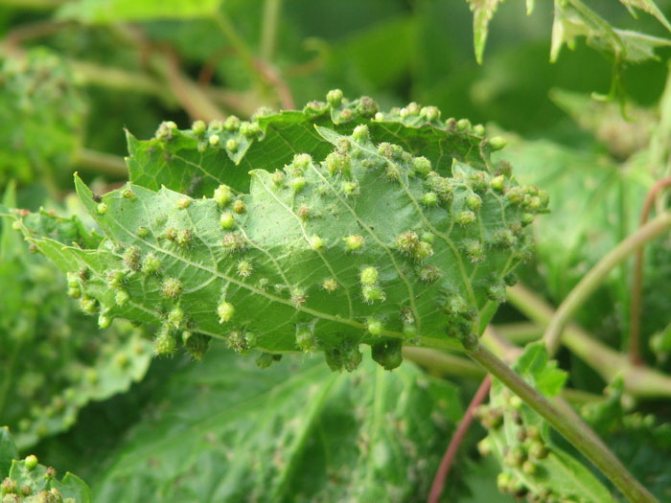

Phyloxera affects not only the roots, but also the leaves of grapes
The pest spreads with soil and infested seedlings. To get rid of the misfortune, grapes are treated with insecticides. Leaves with insect colonies are cut off and burned.
Due to the early ripening of grapes, Victor is not averse to feasting on wasps. To protect berries from them, the following methods are used:
- special mesh bags on the wrist;
- destruction of wasp nests near the site;
- hanging traps.
Wasp nests are safer to destroy at night when the wasps are sleeping, the nest can be burned or drowned in water. Wasp traps can be made yourself from plastic bottles or purchased ready-made in a specialized store. Protective nets for bunches are suitable if the vineyard is not very large, since packing grapes in bags is a painstaking and time-consuming process.
Characteristics of grapes
Check out these articles as well
- How often and how to properly water the flowers
- Black carrot
- Proper feeding of pigs at home
- Pepper California Miracle
Victor grapes have many positive qualities. But he also has disadvantages. In total, these are the characteristics of the species that distinguish it from other varieties.
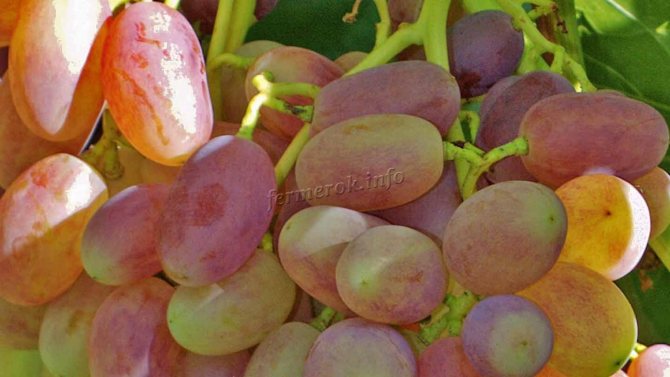

Grape variety Victor
- Early ripening.
- The culture blooms early. This is both good and bad, because during the flowering period of this grape, there may still be recurrent frosts, and this often becomes the reason for a lack of harvest if the flowers are frozen.
- The grape is bisexual, gives stable, high yields.
- Frost resistance up to -23 degrees. For the winter, it is not insulated in the southern regions. But this procedure may be required in middle and northern cities.
- Bunches of commercial quality, transportable.
- The variety is resistant to many diseases, but wasps love it very much, so you need to come up with all kinds of methods for protecting the berries.
- The berries are not peas.
- Productivity from a bush up to 6 kg.
- High palatability - a universal variety. Sugar content 17% with an acidity of 8 g / liter.
Growing grape varieties Victor
Planting Victor grapes is carried out in a sunny place. There should be a lot of sun for the bunches, otherwise the crop will be of poor quality, if at all ripen. The best site is on a hill or plain, on the south side of the site. The type of land does not play a big role, but the soil is chosen fertile. The water table must be low to prevent root rot development.


The grapes are famous for their unpretentious cultivation, easily multiplies, ripens early
There are four breeding methods for the Victor grape variety.
- Grape seedlings are grown most often. To do this, you need to purchase a good seedling (in a store, in the market, on the Internet or from friends), then plant it in a hole with soil fertilized with humus and minerals, and wait until it takes root. Usually, seedlings are quickly accepted and grow, and the harvest can be expected for 2-3 years.
- Grafting of cuttings. Cuttings can be prepared in large quantities - this is not a big problem. They quickly take root, especially if you graft them on a strong perennial. But there is one drawback of the method, you can get a hybrid during vaccination.
Important!
Variety Victor belongs to sun-loving crops, it cannot be grown in the shade or in drafts. It does not tolerate cold winds much more than strong frosts.
- If you already have a vineyard ready, you can simply bend a long vine to the ground, dig it in and wait for rooting. When it grows, it is separated from the mother plant and transplanted separately.
- The last method is seed propagation. The method is beneficial, and the plants grow really well, but the development of the bush will be long and it is not known when the first crop will appear.
Care and harvest
We recommend reading our other articles
- Clover honey
- Green walnut jam
- Violet flower
- Soybean varieties
High-quality care allows you to get a good harvest of the Victor grape variety.
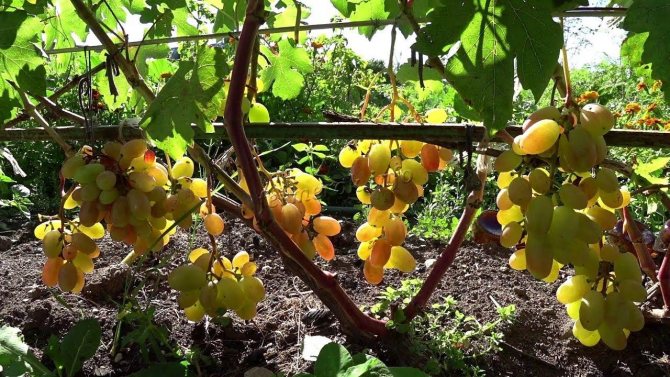

Grape harvest photo
- The winter shelter, if there was one, is usually removed at the end of April, when the snow has completely melted and the temperature has already begun to rise.
- After the winter shelter is removed, you can inspect the bushes and carry out shaping and sanitary pruning. All bad pagons are removed so as not to interfere with the growth of new branches. Re-pruning is also needed in the fall. If the bush begins to grow strongly in the summer, it is pruned so that the vine does not grow more than 1.7 meters.
- Watering is carried out so that the land does not dry out and is not too wet. And in order for the water to evaporate less, the earth can be mulched with coniferous sawdust or bark.
Important!
Wasps often infect clusters. This is particularly problematic when the Victor grape variety is grown for sale. To get rid of annoying insects, it is worth putting each bunch in a separate mesh. You can also set traps, baits for wasps, they help a lot.
- Top dressing is carried out in the first half of summer. To do this, make a mixture of 30 g of superphosphate, 50 g of woody vines per 10 liters of water. You can also use 2 kg of diluted humus in a bucket of water. In the fall, after harvesting, they are usually fed with organic matter - humus or compost for digging.
- For the winter, a light, dry shelter will not hurt so that the root system of the plant does not freeze out in a snowless winter. You don't need to insulate the bush on top, but mulch is necessarily poured under it.
- The Victor grape variety is immune to mildew, oidium, but if they often appear on the site of the disease, at least for prevention it is necessary to spray the bushes with fungicides 3-4 times per season.
The first harvest is usually harvested in early August. Although if the summer was cool, rainy, then ripening can be delayed by about 1.5-2.5 weeks. The bunches usually ripen together, therefore, almost the entire crop is harvested at one time.After harvesting, the crop is stored in a cool place or prepared for transportation.
Possible diseases
The resistance to diseases and pests of Victor grapes has not been studied enough. With poor care and neglect of preventive measures, grapes can get sick with mildew, powdery mildew or phylloxera.
Mildew, or downy mildew, can affect the entire bush: leaves, antennae, flowers, shoots, ovaries. The disease is caused by a peronosporous fungus.
First, yellowish oily spots appear between the veins of the leaves. Then gray fluff grows from the underside of the leaf plate. Berries can also be covered with a fluffy bluish bloom, which makes them unsuitable for eating and processing. And if you still put such fruits on wine, it will inevitably acquire the taste and smell of mold.
Advertisement 3
The disease can be brought into the vineyard with infected seedlings, and the fungus is also carried by the wind and raindrops. The parasite hibernates in fallen leaves, so it is important to maintain cleanliness in the vineyard, to remove litter in a timely manner.
To combat mildew, prophylactic spraying with a 1% solution of Bordeaux liquid is carried out. Such a measure will help prevent disease, but if the spots have already appeared, it will be ineffective. In total, during the growing season, it is necessary to carry out at least three treatments of the vineyard with copper-containing preparations:
- When the shoots have grown to 10-20 cm.
- As soon as flowering began.
- When the ovaries began to form.
In rainy summers, the number of sprays can be increased. Do not process the grapes while the berries are ripening.
Oidium or powdery mildew is also a fungal disease. The propagation routes are the same as for mildew. The shoots of the diseased plant lag behind in growth, the leaves are deformed, and a whitish-gray bloom appears on them. Flowers and bunches look like they have been sprinkled with ashes. The fungus affects most often weakened plants. Against powdery mildew, the vineyard is pollinated with sulfur powder.
Formation of a tall trunk, removal of stepchildren and fallen leaves, destruction of the affected parts of the plant, helps prevent the development and spread of fungal infections.
Reviews about the grape variety Victor
Victor grapes appeared relatively recently. Only a few growers have already tried it in cultivation. What is their opinion about this variety?
- Vera Rozhkova: “Victor grapes are delicious! Sugar berries, easy to chew, and even large. But as for growing, wasps are very upset. Previously, there were almost no them on the site, although 3 varieties of grapes are growing. But now I don't know what to deduce, just some kind of attack! And I don’t want to use strong chemistry, but if you don’t withdraw, they will also settle in the country. In general, this year I will try insecticides, it may help. "
- Alisa Popova: “The first year I have this grape growing. There has been no harvest yet, but the bush has grown quite well. I grow it on a trellis, with a wall, so that it is convenient to collect, and so it will have more light. While they can say that the vine is growing rapidly, it was cut in the spring and will have to be in the fall. In care, an unpretentious look, watering, treatment from pests, diseases - everything is as always. "
- Rostislav Zaitsev: “Victor is a good grape variety in cultivation. It does not require serious care, but I noticed that it is better to ration the crop. Last year I didn't pick anything, and ripening was delayed, but this year I removed half of the bunches, but the rest grew huge and the berries were sweeter! "
Breeding history
The name of the variety appeared in honor of the breeder who was engaged in its breeding, namely Viktor Nikolaevich Krainov. This grape is relatively young: in Russia they learned about it only in the 2000s, and over the past 10 years its popularity has increased significantly.It is assumed that Kishmish Nakhodka and Talisman were used as parent plants, which can be confirmed by the presence of their characteristic features in the new plant.
Did you know? According to rough estimates, to make one bottle of wine, you will need about 600 medium grapes, and if you consider that each of them contains 3
–
4 calories, then the finished product will contain 1800
–
2,400 calories.


